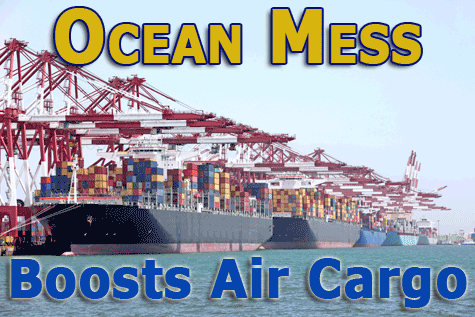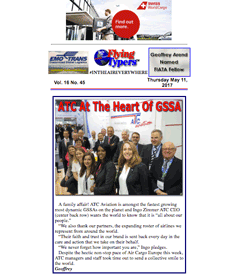
The global air cargo market
has made a rather positive
start to 2017.
As reported in FlyingTypers,
the macro economic environment
has been upbeat, with most
key markets showing growth
and demand on air via East-West
freight lanes encouraging
in both directions.
Disruptive
Ocean
But what has really stood
out this year is how supply
chain disruption in ocean
shipping services can quickly
change the dynamics of air
cargo demand.
Container
Shortages
So far this year, forwarders
and airlines have reported
spikes in demand in Europe
and Asia related to the
shortcomings of container
services by sea. Similar
disruption is also expected
in the U.S. in the coming
weeks, which could also
boost air cargo.
Shipping
Alliance Focus
The key to all this has
been changes in the liner
shipping alliance system
this year.
In simple terms, four alliances
became three with new schedules
introduced in late March
and early April.
But the reality of the realignment
was far more complex.
Hundreds of ships had to
be repositioned ahead of
the new alliance schedules
and many lines also had
to prepare plans for vessel
calls at different terminals
within individual ports.
Given the long transit times
of vessels—the operational
transition started far before
the launch of new schedules
last month and is still
being bedded in now—some
disruption was inevitable.
And where this disruption
has occurred, it has been
the equivalent of a seasonal
cargo boost for the air
freight business, which
has benefitted from modal
shift.
 SkyTeam
Sails SkyTeam
Sails
Stéphane Lemaire,
(right) VP Asia at Air France
KLM Martinair Cargo, said
ocean capacity constraints
in key markets—as
well as shippers diversifying
risk by using both sea and
air in their logistics plans,
not least due to the alliance
reshuffle and the bankruptcy
of Hanjin last year—had
given demand a critical
extra boost this year.
First
Indicators
This first ocean crunch
was apparent in northern
Europe during March, when
export demand was also higher
than expected.
Blank sailings from Asia
during Chinese New Year
enabled lines to reposition
vessels ahead of the transition.
But this led to a shortage
of capacity in Europe for
forwarders loading cargo
for Asia through most of
March and April.
Lufthansa
Chimes In
 A spokesperson for Lufthansa
said demand from Europe
to Asia had been strong
this year, especially to
China, boosted by the lack
of ocean slots available.
A spokesperson for Lufthansa
said demand from Europe
to Asia had been strong
this year, especially to
China, boosted by the lack
of ocean slots available.
“The shift from ocean
to air is clearly one driver
of the situation,”
said Jacqueline Casini,
(left) Director Communications
& Environmental Management.
“It started right
from the beginning in 2017
with a peak in March.
“Capacity became very
tight, with the effect that
our express numbers went
up significantly.
“It remains to be
seen how long this situation
will continue.”
Modal
Shift Beat Goes On
“Modal shift is part
of the overall driver for
increased demand, but not
the only reason.
“Generally,”
Casini said, “demand
for air cargo capacity has
improved over all markets
driven by the high tech,
automotive, and ecommerce
sectors.”
In late April and early
May, changes to port calls
by lines allied with bad
weather also caused lengthy
congestion and delays at
the port of Shanghai, the
world’s largest container
hub.
Casini confirmed ex-Asia
lanes had been vibrant all
year and the carrier saw
a further uptick in demand
from China as ocean delays
worsened.
“There are several
possible explanations, for
example, the ocean delays,
but also the limited capacity
on offer, since authorities
limit extra capacity or
charters,” she added.
Yang
Ming Thing
Another factor in the shipping
conundrum has been the financial
position of Yang Ming. Many
forwarders are wary that
its well-documented troubles
could presage another Hanjin—a
bankruptcy that left supply
chains in disarray—so
avoidance of the line has,
to all effects, taken vessels
out of the market as shippers
and forwarders steer clear,
exacerbating any short-term
local shortages in container
slots, particularly in Asia
where Yang Ming has traditionally
been a major player.
Lufthansa said that it has
now added more capacity
on routes to and from Asia.
“We have been able
to flexibly increase freighter
capacity to meet the additional
demand with the focus on
China (SHA/CAN) and Japan
(TYO),” said Casini.
To
Be Continued
As FlyingTypers went to press, reports of
additional ocean supply
chain disruption linked
to the alliance reshuffle
were emerging at U.S. West
Coast ports.
This is forecast to spread
to the east coast later
in the month.
From our vantage point,
the air cargo industry looks
to be the beneficiary.
SkyKing |





